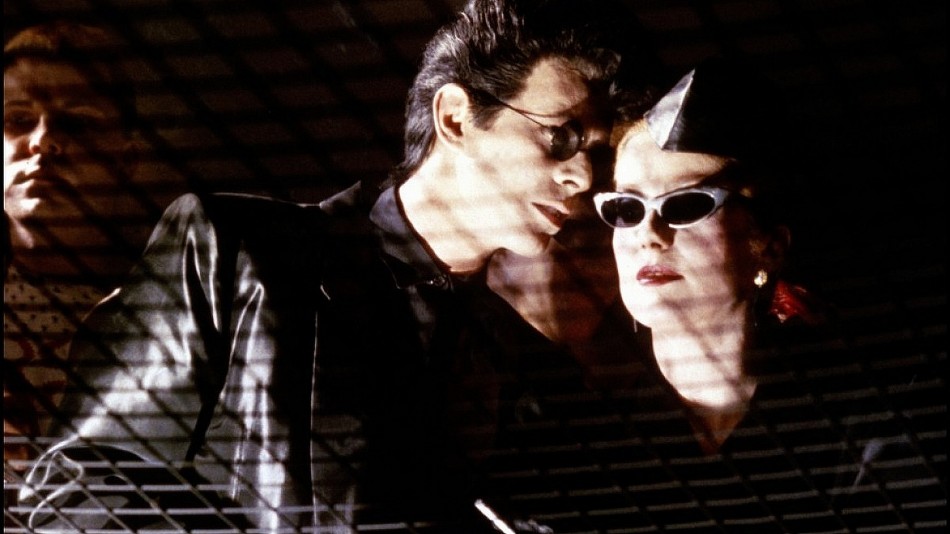
Welcome to the fifth instalment of “Virgin’s View” where I review a classic vampire film without being exposed to any background information or reviews, hence the term “virgin.”
Until now I have only reviewed older films, but after the death of David Bowie on Jan. 10, 2016, I felt inspired by Anthony’s Facebook post to watch The Hunger.
The Hunger came out in 1983 and was directed by Tony Scott and starred David Bowie, Catherine Deneuve, and Susan Sarandon. When I saw Sarandon’s name in the beginning credits, my brain instantly went to a vision of the scantily-clad actress singing “Rose Tint My World” pool side, with Tim Curry and Barry Bostwick in The Rocky Horror Picture Show (1975).
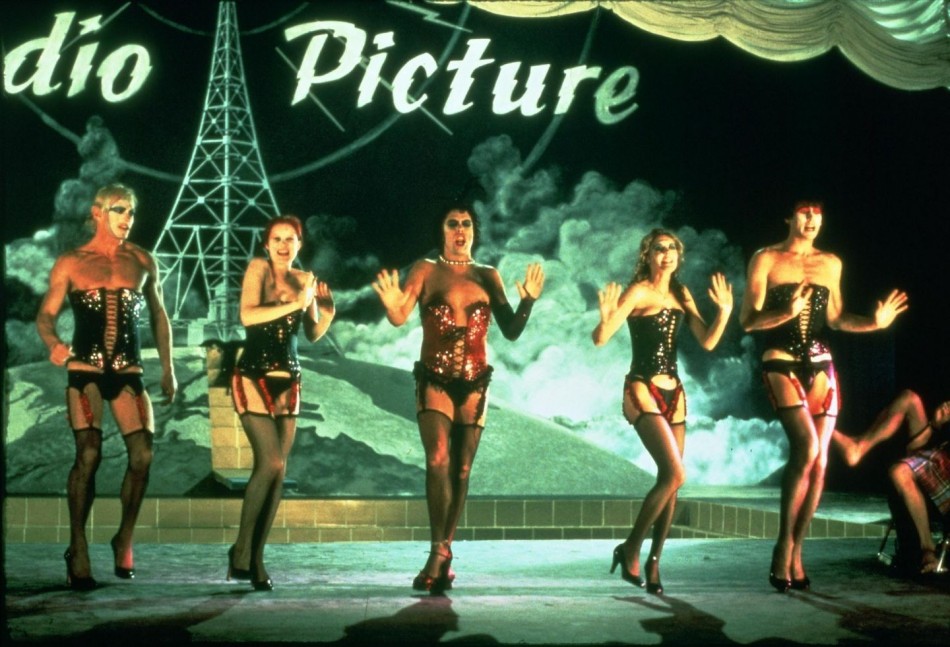
In 1983, I had no knowledge of Bowie’s existence. My earliest memory of him was as Jareth the Goblin King, from the movie Labyrinth (1986). Being a kid and a fan of Jim Henson’s muppets, I loved this movie. I remember his eyebrows reminded me of Spock from Star Trek.
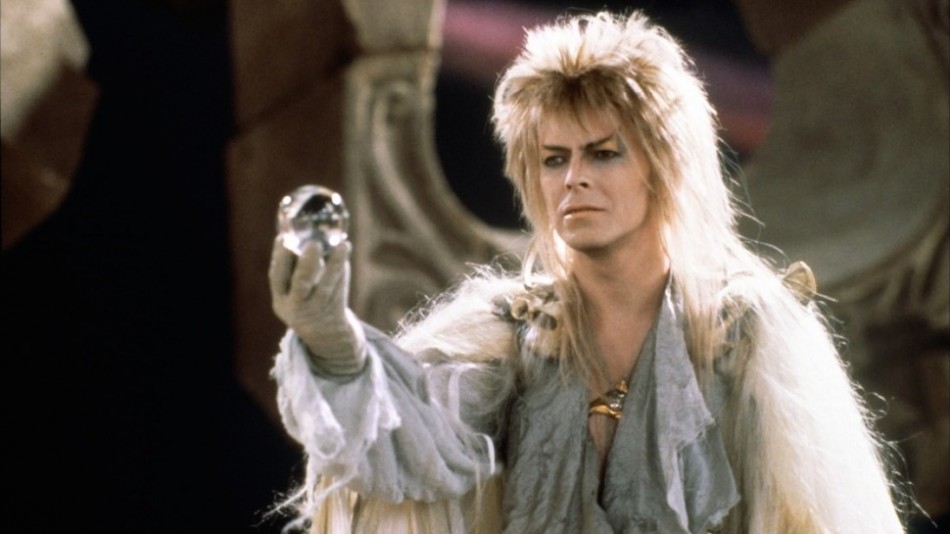
Disclosure
My only exposure to this movie is I know David Bowie starred in the film and I have seen some random photos on Google and Facebook, which supplied me with the release year of 1983. I have no knowledge about the plot or any other details. Before you proceed, beware: major spoilers ahead!
Review
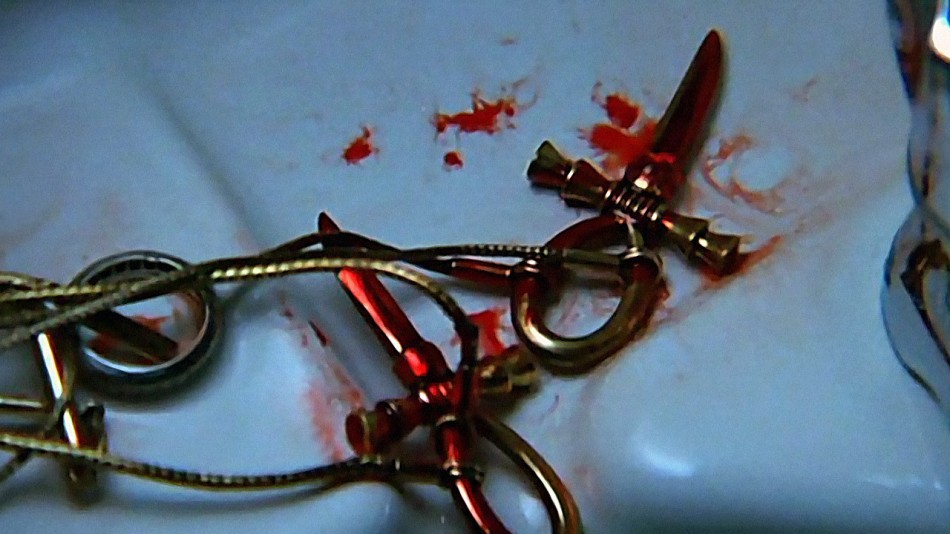
The movie opens in a night club with a suave looking man, John (David Bowie), wearing sunglasses and Miriam (Catherine Deneuve), sporting the same attire, scanning the crowd for what appears to be some company. To add to the ambiance, we have some crazed looking goth guy in a cage crooning a familiar tune I recognized: “Bela Lugosi’s Dead.”
John and Miriam pick up another couple and leave together in a limo. They arrive at a house and both couples pair off: John strips the woman down naked in the kitchen, while Miriam gets busy with her new guy in the next room. The love session only lasts moments before John and Miriam each slice and dice their new friends with a sharpened ankh that doubles as a necklace.
This scene totally reminded me of episode one in American Horror Story: Hotel, where The Countess (Lady Gaga) and Donovan (Matt Bomer) pick up some “takeout” in a cemetery.
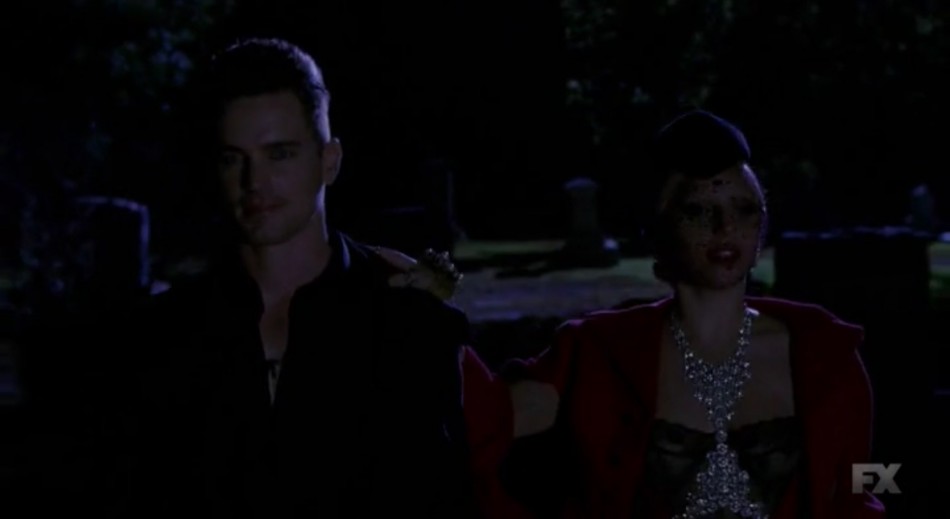
What differs is the obvious characteristics of the 1980s that the film accentuates: everyone is busy looking cool while smoking and apparently Corey Hart’s “Sunglasses at Night” is a code to live by. Also the scene flashes between the demise of the two guests and a monkey going insane in a cage, while he slaughters his furry roommate, Betty. Between the crazed monkey, classical music and lack of dialogue my initial impression was: what kind of artsy film have I gotten myself into?
John and Miriam package up their expired play toys in garbage bags and drive home, tossing them into what appears to be an incinerator conveniently located in their basement. A sensual shower scene ensues and before they lock lips John says “Forever and ever.”
Miriam sleeps while John is plagued with insomnia and we jump to Sarah Roberts (Susan Sarandon), discussing how her psycho monkey is manic and has not slept in fifty-six hours and is struggling with insomnia as well. John bounces in and out of what appear to be memories of him and Miriam long ago: their clothing and the classical music score, reminds me of the movie Amadeus (1984). We hear Miriam this time say, “Forever and ever” before they embrace.
Miriam discovers Sarah on a television talk show, explaining about her research into progeria, a terminal disease where a person prematurely ages. Not exactly the same as The Curious Case of Benjamin Button (2008), but close enough. Miriam then ventures to Sarah’s office in search of some answers about aging and is consulted by a male doctor wearing sunglasses and smoking in the office. How professional.
Meanwhile John sits alone at home reading a book written by Sarah and runs his hand through his hair, only to have it fall out in clumps. Miriam returns and he asks her how long it is going to take and how long the others took? She claims she does not know and tries to comfort John by explaining she prayed she would never have to lose him or live with his suffering. John wants to know who will be next and keep her company when he is gone. She refuses to answer.
This scene made me quite sad as I am assuming John is a dying vampire. All the talk about aging, his hair falling out and how long it will take, hit too close to home with Bowie actually passing Sunday. I didn’t expect this to be in the movie. I guess when I think of vampire films, I tend to associate vampires dealing with their immortality instead of facing the “true death” as Bill Compton would say.
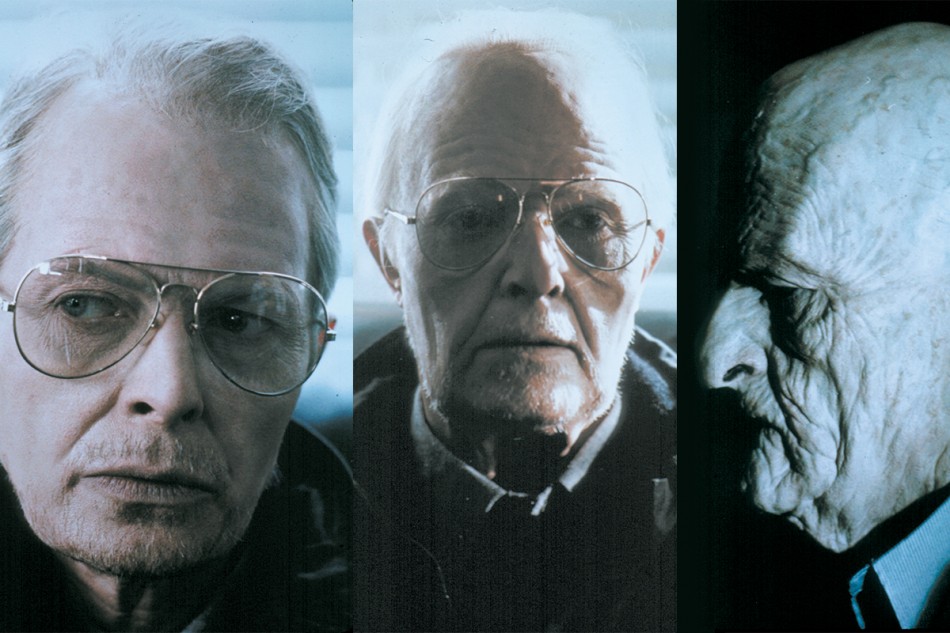
Not satisfied with Miriam’s answers, John sought out Sarah for help. He tried to explain how yesterday he was thirty and today he had liver spots on his hands. She mistook him for a crazy guy and left him in the waiting room for the afternoon while he aged considerably. As John ages, so does Sarah’s test monkey. Maybe this is a representation of John?
He storms out and ends up eating a girl Miriam teaches music lessons too. Miriam came home and found John, now an unrecognizable old man. He demands she kill him and Miriam refuses. Angry, John lashes out saying, “Forever and ever, do you remember? Never grow old. Do you remember? Forever young!”
Being at the forty-two minute mark, I thought how could Bowie die this early in the film? John asks for one last kiss. Miriam does reluctantly and then effortlessly carries him up to the attic in her arms. I guess she either works out or has some super vampire strength going on.
![TITLE: HUNGER, THE • PERS: DENEUVE, CATHERINE / BOWIE, DAVID • YEAR: 1983 • DIR: SCOTT, TONY • REF: HUN001BK • CREDIT: [ THE KOBAL COLLECTION / MGM/UA ]](https://vamped.org/wp-content/uploads/2016/01/TheHunger-1600x900-c-default-e1452858710925-1.jpg)
What I can piece together at this point in the film is Miriam turned John into a vampire, but he was not her first. He was essentially another notch on her bedpost. Instead of doing the humane thing and killing the poor bastard, she locks him up in a box so he can die gradually on his own. Does he actually die or just rot away in the box forever? Why doesn’t Miriam age and did she knowingly turn her ex-lovers while lying about eternal life, when in fact she knew the truth?
I think Miriam is ancient because she comments the artwork in their apartment ranges from 500 to 2,000 years old and its owned by her family. They don’t have fangs like typical vampires, but instead use the cutting method like in American Horror Story: Hotel.
Miriam did not wait long for her sheets to cool. She seduces Sarah, who dropped by to check on John and is told he left for Switzerland. Within minutes, Sarah ends up in bed with Miriam wearing only her heals and panties. And yes folks, they shared more than one type of bodily fluid.
The next day Sarah’s people at the lab notice she is sick and acting strange so they analyze her blood, only to find her system is chalked full of an “inhuman blood” they cannot identify. They also discover a mark on her arm and Sarah pretends to know nothing about. Instead of going to a specialist, she makes a detour to Miriam’s place.
Sarah demands an answer and Miriam denies nothing. She explains they exchanged blood; it is all “natural” and there is nothing to be frightened about. I don’t know about you, but I don’t think drinking other people’s blood is natural, unless you are a sanguinarian.
They have a tussle and Sarah storms off, returning hours later because the hunger has taken over. She is all sweaty and has done a one-hundred-eighty degree turn from a respectable doctor and now resembles a strung out sick junkie having withdrawal. She runs into a very young Willem Dafoe who has one line in a scene. I almost didn’t recognize him.
Sarah’s boyfriend, Tom Haver (Cliff De Young), shows up looking for her. Miriam calculatingly sends him to Sarah’s aid, hoping she will feed on him. We never see it, but Sarah shows up downstairs giddy and covered in blood, so I can only assume she ate him.
Miriam repeats history and tells Sarah they will be together “Forever and ever.” I guess if you have centuries of practice, it gets easier each time. She explains how Sarah is bound to her forever and cannot let her go. She sells mortality, but the coffins suggest otherwise.
This is when the shit hits the fan. Sarah grabs the ankh and stabs herself in the neck as Miriam and her are kissing. Miriam freaks out and screams saying she can’t leave her. Miriam makes the trek up to the attic again to stuff Sarah away into a coffin, only things don’t go as planned.
Chaos ensues and the floor jolts like during an earthquake and Miriam gets tossed about. All the coffins slide across the floor as the pigeons go nuts, flapping all over. She leaves Sarah dying on the floor as she fends off all her bottled-up rotting ex-lovers that have come loose and are not too happy.
She pleads with them and says she loves them all. In desperation trying to get away, she falls over the railing plummeting about four stories. She is not dead, but instantly starts thrashing and aging. Keep in mind this was done in the early 1980s, so the effects are pretty cheesy. Also all the reanimated corpses rot as Miriam rots, until they crumble to the ground. Did she die because Sarah denied her love? Who knows at this point, I am just guessing.
We end the movie with a real estate broker selling their empty house and he explains part of the proceeds from the sale will go to a research facility. This made total sense when we see Sarah alive and kicking in the final scene. Did she plot the entire time to get Miriam’s wealth? They did show a coffin in storage so perhaps Miriam got what she deserved after everyone else she had screwed over through he centuries.
The plot of this movie I found really strayed from the stereotypical vampire movie: no fangs, little blood, and lots of sunglasses and smoking. Miriam had immortality, but couldn’t handle the loneliness price tag it came with. I would love to know more of the backstory on this, but that will have to wait till after this review.
I felt some of the effects were comical due to the era the film was made in. The funny noise you heard every time they tore their ankh from their neck when making a kill, made me think of cartoons. Same with the cheesy photos of blood cells that danced across the screen when they fed. All the smoking reminded me of one of my favorite movies from the 1940s, His Girl Friday (1940). Anyone and everyone smoked back then.
The music was all over the shop, but always eerie and intense. It enhanced the mood and I liked the fact a lot of it was piano and cello, which were the instruments Miriam and John played. I enjoyed the intro track played in the club. I actually have a few versions of this song in my music library and had not heard this one before. I would like to know the artist or if it was just a one off singing it in the movie.
Overall the movie entertained me although some of it I found predictable. I enjoyed seeing Bowie in another role besides a singing Goblin King dressed in high heeled boots and tight pants. I would have liked to see him have a bigger part in the film and I am curious how long it took them to put on his geriatric make-up towards the end.
“The Hunger” could represent a number of things in the movie: immortality, blood lust, wealth, power, or love. Miriam’s desperation to be loved ended up being her own downfall and turned the tides, locking her away.
This week the world lost an amazing and talented artist, but this film will preserve David Bowie’s immortality on the big screen for generations to come. Who says only vampires live forever?
Notes:
- Anthony’s Facebook post: Anthony Hogg, post on The Vampirologist Facebook group, Jan. 10, 2016, accessed Jan. 11, 2016, https://www.facebook.com/groups/thevampirologist/permalink/442807955926218/.
Further Reading:
- Erin Chapman, “A Virgin’s View on ‘Horror of Dracula,’ “ Vamped, July 29, 2015, http://vamped.org/2015/07/29/a-virgins-view-on-horror-of-dracula/. The previous installment of “Virgin’s View.”
I, too, did a virgin viewing of the film this week. I found it sad, as the character of John began aging and Miriam was already looking for her next lover. It was an artistic movie, yes, somewhat dated, but overall enjoyable. The ending mystified me, though. Not enough was explained throughout the movie to make it understandable, so I’ve decided to read the book by Whitley Streiber and find out the answer to some of the questions I have. I agree with you that it was disappointing that we didn’t get to see David in all his gloriously cool beauty for very long before he began aging, since the scriptwriter evidently wanted to spend more time on the lesbian love scenes, I assume. But overall I found it enjoyable despite it’s flaws.
Thanks for sharing Holly! You will have to let me know what you think of the book. I love doing these reviews as it’s like waiting for Christmas until I am done to look up what the film is about. 🙂
The song, you rightly recognised, was Bela Lugosi is Dead. The band were Bauhaus, whose song it was.
She didn’t refuse to kill him, she can’t kill him. They are truly immortal (she never lied) but those she turn age after awhile and become locked in their ancient husks.
The reason isn’t explained in film – but comes from the book the film is based on (by Whitley Strieber). Miriam is a vampire, another species, she is creating companions by introducing her blood to humans and her blood turns them but as they are originally human the youth does not last.
Incidentally, in the book Miriam does not die/become an aged thing in a coffin, and there are two further books in the series. Also Miriam has a stinger on her tongue that she uses to feed (the turned humans use a knife or blade.
Thanks Andy! I was waiting for your comments lol. Since you have read the book, does it explain how long of a life her lovers get once they are turned? I was curious? And if they don’t die, they just rot forever in their little coffins? How depressing!
From memory (I read the book years ago) it varied but it was longer than human life span. There might have been an aspect in the book of her not being able to bring herself to kill them, thus making it possible – I can’t quiet remember, but the inference in the film was they couldn’t be destroyed.
See that would be the key. If you didn’t get many additional years to your standard human life expectancy, would it be worth it? Also they kept saying “forever and ever,” which makes me think did she sell it to them as that and not explain, you just get a few more years on top. I was trying to go by the period clothing they would bounce back in John’s memories to pin point how long he had been alive in that sense.
In fact, the sequel of the first book of Whitley Strieber are less interesting than the first one. To my mind, what is very interesting in this movie is this idea of blood disorders, and the premature physical degeneration of the body that is linked to it. The book was published in 1981, the movie screened in 1983, at the same time as the first signs of official statement on AIDS. To me, it’s far more than a hasard.
That usually happens with sequels unfortunately, they never live up to the original. Yes the blood disorder part was interesting, the movie wasn’t what I was expecting from that aspect. Was it just the two books she wrote in the series?
I saw The Hunger years ago, and it remains one of my favorite vampire films to this day. First time director Tony Scott (late brother of Ridley) opts for photographic choices suggesting a dreamy bathroom tissue commercial for vampires. Catherine Deneuve and David Bowie make an ideal pairing as the decadent vampire lovers. Period scenes showing their early courtship are suggestive of Stanley Kubrick’s 18th Century masterpiece Barry Lyndon (1975). This impression is backed up by the inclusions of Schubert’s Piano Trio #2 in E-Flat Major and Delibe’s Lakmé: The Flower Duet. Essentially, the film plays like a commercial director’s take on an art film. Miriam’s seemingly endless museum-like house reflects her age and evolving tastes. As for Bowie’s eventual consignment to a coffin in the attic with Miriam’s former lovers; maybe she hoped an eventual cure would free them from their debilitated states. I would love to see a sequel with Sarah continuing in the same “vein” as Miriam.
Thanks Norman for the music information. I love it when readers are able to contribute what they know. It makes doing these more fun as everyone gets involved with comments after. A sequel with Sarah would be interesting, I wonder if it is something that Sarandon would do after all these years?
Peter Murphy — the front man for Bauhaus — is in the cage. That was their big song, and the other versions you’ve heard are covers / homages. Bauhaus were one of the “founding” bands of the goth genre.
In the scene where John fails to feed upon the young guy skating, the song is Iggy Pop’s “Fun time”. Iggy & Bowie have a long & sorted past together, so this was another inside joke.
At the time of the movie indoor smoking was quite common, even in hospitals. It was common to offer cigarettes to strangers as a social introduction or to calm them down, so their use in the film isn’t as much of a statement as it feels like today.
The AHS season was a homage to the film, thus all the references / familiarities you noted.
For years, there’s been a running joke among my friends that Bowie didn’t age in real life because he made this movie where he aged instead, a la “Portrait of Dorien Grey”. I guess that joke isn’t funny any more (it’s too close to home and too near the bone).
Thanks for the info Mr. Kitty!
I love old black and whites from the 1940s and yes back then smoking was an even bigger social thing. Everyone did it. I guess I used to now when no smoking anywhere.
In regards to Bauhaus, I didn’t know they contributed to the genre that much. Always look forward to people’s comments on my Virgin’s Views. 🙂
I think, from Sarandon’s lab work w/ the monkeys (accelerated decrepitude ), it’s suggested that Deneuve’s character is a carrier of this particular strain of blood disease, which takes its toll on typical mortals within the span of that mortal’s lifespan… Ergo, because a vampire is immortal, the symptoms of the disease my take 200 years to show up; perhaps centuries more.
The point is, it’s a flaw in her blood, which dooms those she’s turned to age and wither, eternally, once the pathogen kicks in. But because it cannot kill them, they simply age and rot until they crumble to dust. Deneuve, however, maintains eternal youth and life.